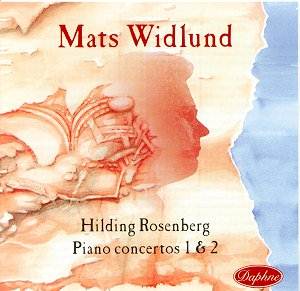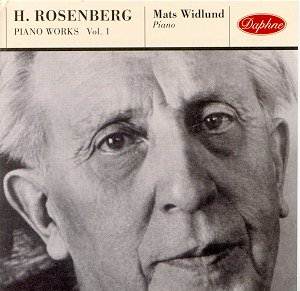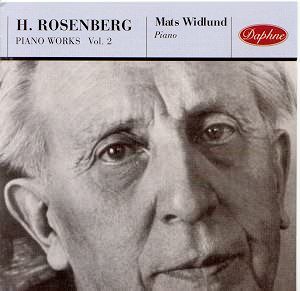HILDING
ROSENBERG (1892-1985) The Piano Concertos Piano Concerto
No. 1 (1930) [24.58]Piano Concerto No. 2 (1950)
[35.56]  Mats Widlund (piano) Swedish Radio SO/Petter Sundkvist
Mats Widlund (piano) Swedish Radio SO/Petter Sundkvist
 rec
Berwaldhallen, Stockholm, 12-15 Sept 1997 No. 1; 19-21 Aug 1997 (No. 2)
DAPHNE DR 1006 [61.20] rec
Berwaldhallen, Stockholm, 12-15 Sept 1997 No. 1; 19-21 Aug 1997 (No. 2)
DAPHNE DR 1006 [61.20]
How to order this CD |

Daphne are a small label whose catalogue holds some considerable and unique
treasures. Their selection of repertoire is unerring and has resulted in
three discs of piano music by Swedish composer, Hilding Rosenberg. The present
disc of the two piano concertos is joined by two discs of Rosenberg's solo
piano music. The pianist providing the unifying approach is the fiercely
virtuosic Mats Widlund (familiar from the Chandos CD of the Stenhammar piano
concerto No. 1 - a very different work from the Rosenbergs) as adept at the
motoric cross-rhythms of the first concerto as he is at the coolly
impressionistic aspects of the solo piano music.
The two-movement first concerto was written for Sven Brandel and given to
him (probably for appraisal). The work seems never to have been performed
until 1992 shortly after it was discovered amongst Brandel's papers. The
first movement is rhythmically active - torrentially so! There is, for me
more than a touch of the convulsive martellato of Shostakovich's Piano Concertos
1 and 2 and the Khachaturyan Concerto-Rhapsody in this steam-hammer
blizzard. There is some relief in the middle of the movement and here and
there a reassuring touch of the Scandinavian romantic school. The 15 minute
adagio espressivo combines calming honeyed string textures and some
patent romanticism (at times with a slightly vinegary skew) with strolling
clangorous piano chords marching up and down the scale. If you think of Alwyn
with a touch of midnight sun and a twist of Bergian harmony you have the
picture. Interesting to note William Alwyn's first piano concerto, Ireland's
concerto being exactly contemporaneous while Bax's Winter Legends and
John Foulds' Dynamic Triptych date from 1929. There is no third movement
- it seems that none was written so, rather like Schubert's Eighth, the work
ends 'unfinished'.
The second concerto (for years thought of as the only Rosenberg piano
concerto) is in three movements - the usual fast-slow-fast. The style is
somewhat Bartókian. The 'fast' first movement finds plentiful time
to dream (2.10) amid the corn-stooks - a sort of 'Nights in the Fields of
Sweden'. This mood is blown away by a storm-blown gale of strings before
we return to the delectable fields. Ends in a lissom fast-beating anthem
recalling Hindemith's more emotionally engaged string writing. The opalescent
piano writing made me think of Bax's Morning Song: Maytime in Sussex.
The second movement is at once both quieter and tougher of comprehension
though again it is crowned by the disruption of one of those torrential passages
for orchestra and soloist. This is more Bartókian and also has quite
a dash of what I recognise as Rawsthorne whose own two piano concertos 1942
and 1951 (if we ignore the two piano concerto) would make an interesting
contrasting study. There is also a hint of Frank Bridge's Phantasm
about the music.
The third movement, Allegro Giusto, is catchy, with romantic elements
synthesised into the faintly off-key harmony: Sibelius with a hint of Prokofiev
in the Russian composer's least accommodating language.
It was good, at long last, to make acquaintance with this concerto in a good
recording. The performance is every bit as atmospheric as the radio tape
by which I came to know this piece. The tape features Käbi Laretai (who
premiered the piece) and the Swedish RSO conducted by Hans Schmidt-Isserstedt.
Speaking of Laretai and Swedish piano concertos, you might like to explore
the single movement piano concerto (Concerto Ricercante, 1959) of
fellow Swede, Gösta Nystroem (1890-1966). Laretai recorded this on a
Swedish Philips LP (839.277) with the Stockholm PO conducted by Sixten Ehrling.
This is several degrees more gristly and dissonant than the Rosenberg works
but quite rewarding and very atmospheric especially in the broken mirror
'La Valse' of the central section. Come on BIS and Paavo Järvi - let's
have this on a CD with the same composer's Sinfonia Del Mare or perhaps
Daphne will beat them to it?
Excellent notes (English and Swedish). Two intriguing concertos - rewarding
particularly for those who like the piano concertos of Bartók, Rawsthorne,
David Diamond or Schuman - all served with Swedish relish.
These concertos are not for those who seek out Rachmaninov style works: for
that you need to delve into the British Rachmaninov scion, Reginald Sacheverell
Coke (1912-1975, six piano concertos, 1920s, 1933, 1938, 1940, 1947, 1951),
Sergei Bortkiewicz (1877-1952, at least three concertos - perhaps four if
you believe some sources) and Ivan Dzerzhinsky (1909-1978, now when is some
going to record the Dzerzhinsky three piano concertos 1932, 1934 and 1945?).
Apart from Bhagwan Thadani's disc of the second and third Bortkiewicz concertos
these works remain obstinately un-recorded.
A most successful effort all round and testament to the firmness of resolve
of Daphne's MD, Björn Uddén, as well as to Widlund's dedication
and the skilled sympathy of orchestra, conductor and engineers.
Reviewer
Rob Barnett

HILDING
ROSENBERG (1892-1985) The Piano Works Vol. 1 Plastiska Scener
(1921) Piano Sonata No. 1 (1923) 11 Sma
Föredragststudier (1925) Piano Sonata No. 3 (1926)
Improvisationer (1939)
 Mats Widlund (piano) Mats Widlund (piano)
 rec
Concert Hall, Örebro, 14-16 May 1995 DAPHNE DR 1001 [65.06] rec
Concert Hall, Örebro, 14-16 May 1995 DAPHNE DR 1001 [65.06]
How to order this CD |

During the 1920s Rosenberg (a man in his immortal twenties) was very productive
of piano works. They tumbled out in profusion and then were forgotten. He
returned to piano music in the very late 1930s and 1940s but to nowhere near
the same extent.
The Plastiska Scener - an eight piece sequence - is deeply and instantly
attractive: pastoral lullabies, glittering scales (the Tempo Giusto
arpeggios uncannily predictive of the third movement of Bax's Winter
Legends), Brahmsian concision slightly curdled, macabre brevity (the
allegretto is 19 seconds long), a Presto like a truncated concert
study by Frank Bridge and an unresolved andantino.
The First Sonata's somnambulistic doldrums in the first three movements and
the insect scuttling of the Allegro comodo contrast with the
Prokofiev-Bach confection of the Third Sonata's first movement, the thickened
syllables of its Debussian lento, the sunnily smiling Scherzo and
the ringing Poulencian brightness of the Allegro energico. The Third
Sonata is certainly a more accessible work although its impact is lessened
by a brief recording distortion in track 26 (Scherzo) where for a
few instants the sound crumbles and drops out completely.
Wind forward to 1939 and the eight Improvisations. These depart from the
Schoenbergian antics of the first sonata. If anything they are Debussian
(some Prokofiev in these as well) and are played by Widlund with the greatest
sensitivity. Listen to his control of dynamics in the Moderato (track 33)
and woodpecker brightness of Allegro Vivace (34). The opening and
closing Allegro Energico has the awe and grandeur of Mussorgsky's
Kiev Gate.
The eleven studies (1925) trace a charming and unsentimental line from Grieg.
Sample tracks 22 and 23; the latter might almost trace a line from one of
Macdowell's woodland flowers or Peterson-Berger's delectable
Frösoblosomster (wonderfully recorded on BIS by Noriko Ogawa).
Special thanks go to the Swedish National Council for Cultural Affairs for
their singular support for this project carried over two solo piano volumes
(1001 and 1003) and into the piano concerto disc (1006).
Reviewer
Rob Barnett

HILDING
ROSENBERG (1892-1985) The Piano Works Vol. 2 Suite
(1924) Piano Sonata No. 2 (1925) Piano Sonata
No. 4 (1927) Tema con Variazioni (1941)
Sonatina (1949)
 Mats Widlund (piano) Mats Widlund (piano)
 rec
Concert Hall, Örebro, 13-16 April 1996 DAPHNE DR 1003 [76.32] rec
Concert Hall, Örebro, 13-16 April 1996 DAPHNE DR 1003 [76.32]
How to order this CD |

In relation to my discovery of Rosenberg I owe a debt, deep and wide, to
my favourite writer on Scandinavian music, Robert Layton. It was through
Mr Layton's writings in 'Golden Age' Gramophone rather than its current
thought-byte style Brummagem tin - no disrespect to my native Birmingham)
that I sought out Rosenberg's music in the 1970s and 1980s. We can enjoy
reading classic Layton (and I hope, both Martin Anderson and the much-missed
Richard D.C. Noble - the latter once such a pillar of Records and Recordings)
in the newly launched International Record Review.
One day I hope to have the excuse to review the Rosenberg Symphonies - especially
the middle period ones: 3 (1939, The Four Ages of Man, after Romain
Rolland), No. 4 Johannes Uppenbarelse (1940, his Revelation of
St John - Apocalypse symphony - written four years after Franz Schmidt's
Book of the Seven Seals in the year of the German occupation of Norway
and Denmark) and No. 5 Hortulanus (1944).
Of the Fourth Symphony I treasure both the Caprice CD (CAP21429) with Gothenburg
forces conducted by Sixten Ehrling with Håkon Hagegård as well
as a radio tape (1979 BBC broadcast) of a performance conducted by Herbert
Blomstedt (has he ever been permitted to do No. 4 - or any Rosenberg - in
San Francisco I wonder?) with Swedish Radio forces and again with Hagegård
as the baritone soloist.
There is some extremely attractive music on this disc. While the two sonatas
can be a challenge the other works here are immediately amicable without
being anodyne.
The Gallic impressionism Suite: Delicately tuneful miniature chiming
impressionism of Arabesk and Pastoral, Pierrot wanderings of Impromptu. Nothing
Schoenbergian here. Prize listening for anyone partial to Ravel or Goossens
The polished Satie-like scattiness and repose of the second sonata is not
to be preferred to the fourth sonata. The latter, in the first movement,
rests moored at ease on an unthreateningly rocking ocean - even slightly
Brahmsian. This is succeeded by an earnest perpetuum mobile and a
classic andantino ruffled by breezes predictive of Shostakovich -
or at least so they sound. 1927 is far too early for any direct influence.
On into the 1940s. The Theme and Variations entrancingly threads delicate
silken lines into a glistening impressionistic curtain soon to be developed
in angry turbulence, impatience and drizzled peace. Shostakovich is certainly
a glassy influence in the 1949 Sonatina (its Allegretto rather like
parts of Niels-Viggo Bentzon's Det Tempererede Klaver on ClassicO
CLASS CD 210-225).
The playing time is very generous. Notes are good though silent on Sonata
No. 4.
If you are pressed to choose between volumes 1 and 2 go for No. 1 - a fine
production all-round.
Reviewer
Rob Barnett

http://www.daphne.se
bjorn@daphne.se
tel/fax +6 8 81 69 28
Daphne Records AB
Slätbaksvägen 48
S-120 51 Arsta
SWEDEN
